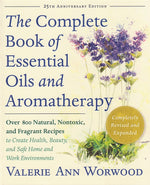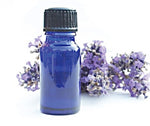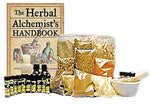Aromatherapy
Karen Charboneau HarrisonShare
© Copyright 2023 Karen Charboneau-Harrison, All Rights Reserved.
How Aromatherapy Works • How Essential Oils Are Collected • Using Essential Oils • Symptom List • Recipes • Aromatherapy Book Listing • Essential Oils Listing
Please be aware that the use of essential oils in aromatherapy is an art-science which does affect the human body for good if used properly or ill if used improperly. Proceed slowly in your application of aromatherapy being vigilant in your observations. Please consult trusted references like The Complete Book of Essential Oils and Aromatherapy by Valerie Ann Worwood as to the toxicity and strength of various oils. Use common sense and in general do not ingest or apply essential oils directly to the skin. Isis Books and Gifts carries an excellent selection of 100% natural, pure ESSENTIAL OILS at very reasonable prices.
Aromatherapy is the therapeutic use of the essential oils of plants. It can help to relieve stress, restore balance on all levels, contribute to the rejuvenation and regeneration of the individual. As an 'official' therapy, it is a 20th century science with its roots in ancient Egypt, India and the Mesopotamian areas. The word was first coined by a French chemist, Gattefosse, in 1928 when he discovered the healing properites of lavender oil as a topical application for burns. As early as 1946 another French scientist, Valnet, was using essential oils extensively as a part of his physical and psychotherapeutic treatments. Two modern founders of the Aromatherapy movement, Marguerite Maury applied his research to her beauty therapies and Robert Tisserand to massage therapy.
Essential oils are pure, aromatic substances extracted or distilled from flowers, herbs, trees, fruits and roots. They each have their own specific properties, like herbs, and are highly volatile, concentrated with molecules, and are 75-100 times more concentrated in an essential oil than the dried plant. They've been called the life force or quintessence of the plant. Essential oils are blood of the plant, contain its life force as well as its chemical make-up. Most are clear, some are colored. Essential oils are odorous and highly volatile. Also, essential oils are soluble in alcohol or fixed oil, but only partially in water.
Essential oils consist of chemical compounds which have hydrogen, carbon and oxygen as their building blocks. The chemical families of essential oils are:
The same plant grown in a different region under varying conditions (soil, temperature, rain) can produce essential oils with diverse characteristics (chemo-types). Therefore it's important not only to know the oil by its Latin botanical name but also by its place of origin.
[ GO TO COMPLETE AROMATHERAPY BOOK LISTING OR GO TO COMPLETE ESSENTIAL OILS LISTING]
Works in 4 distinct though interrelated ways:
By contact with the skin, essential oil's small molecular structures penetrate the dermis into the blood and lymph stream, strengthening and toning the body's organs and the hormonal, nervous & immune systems. Through inhalation, the molecules stimulate a sensory cell in the back of the nose which travels to the limbic brain, effecting neuro-chemicals, the memory, and emotions.
[GO TO COMPLETE AROMATHERAPY BOOK LISTING OR GO TO COMPLETE ESSENTIAL OILS LISTING]
The most common method of extraction is steam distillation. However, cold expression is used for most citrus oils and a method of solvent extraction from fresh, raw materials is used for Concretes (concentrated, waxy, solid or semi-solid - vanillin) where heat would adversely effect extraction. Absolutes are obtained in a 2nd step from the concrete using pure alcohol (viscous, semi-solid or solid perfume material - rose) and resinoids (prepared from natural resin material such as balsams, gum resins - myrrh) typically used as fixatives.
[GO TO COMPLETE AROMATHERAPY BOOK LISTING OR GO TO COMPLETE ESSENTIAL OILS LISTING]
The cleaner the individual's system, the more effect and quicker. Essential oils use the life force of plant as well as the chemical ingredients. From botanical sources, not synthetic, not animal. essential oils are made up of many major constituents, minor constituents and trace elements which do not occur in synthetics. Different oils are absorbed by the body at different rates:
Turpentine - 20 mins. Eucalyptus and Thyme - 20-40 mins. Anise, Bergamot, Lemon - 40-60 mins. Citronella, Pine, Lavender, Geranium - 60-80 mins. Coriander, Rue, Peppermint 100-120 minutes.
Essential oils are powerful and concentrated; use minute amounts. 1-3 drops on cotton; 3% essential oil, 97% carrier oil for massage.
There are almost 200 essential oils in therapeutic use. As it has become more popular, synthetic blends have been created to mimic true essential oils, and you must be careful to ensure you are buying an essential oil that is not synthetic. Nose test - does it have underlying petrochemical smell? Air test - drop of oil on parchment, test smell in 20 minutes to an hour, does it stay true?
Use simples (a single oil) or in blends of not more than 5 oils. Do not use too many oils together as it confuses the body's reactions. In blends always use base, middle and top notes.
Base Note, least volatile; for nerves, anxiety, childhood stuff, mucus membranes. Fixative, holds back top note. Patchouli, sandalwood, cypress are examples.
Middle Note, medium volatile; for digestion, metabolism; always use one in blends to provide pathway between base and top. Cardamon, lavender, peppermint.
Top Note, very volatile; lightest scent, first smell. For lethargy, depression, motivation. Eucalyptus, rosemary, orange.
When blending consider all present symptoms and factors, physiological and psychological. Diet; chronic or acute symtoms; anxiety or depression; physical symptoms. One of the common misconceptions about both herbs and essential oils is that they can be used indiscriminately in total safety. You need to KNOW what effects oils can have and remember that they can contain Terpenes which can be toxic to the system in large doses and irritate the user's skin especially when exposed to light.
BASE - cypress1, patchouli2, sandalwood2
MIDDLE - melissa2, clary sage2, rosemary1, geranium2, cardamon+, hyssop2, jasmin2, rose1, neroli2
TOP - pennyroyal2, eucalyptus1, lavender2, bergamot2, peppermint2, chamomile1
1 yin
2 yang
AROMATIC BATH water @ 95 degrees, lukewarm. Fill bath, put 3-5 drops essential oil as you enter. Or, mix 3-5 drops essential oil in 1 tablespoon vegetable oil then add to water. (basil, pepper, peppermint, rosemary, lemon, cinnamon, cardamon, melissa, bergamot can be irritating to skin). Soak, breathe deeply, massage the skin.
COMPRESSES soak cloth (diaper, muslin, handkerchief) in hot water with 2-3 drops essential oil. Wring and place directly on afflicted area until it has cooled to body temperature & repeat. Cold compresses are similar, fill bowl with ice water, add oils, squeeze & apply at least 2 hours, overnight is fine. This is especially good for migraines.
FOOT BATH for headache, migraine, colds. Hot as you can stand, add oils with feet, wrap body.
INHALATION 1-3 drops essential oil on cotton ball, oil diffusers, steaming on stove - three deep inhalations per minute. For subtle energy change in room use light bulb ring, diffuser or steaming.
MASSAGE penetrates skin, 3% essential oil to 97% carrier oil. 3-5 drops essential oil per Tablespoon carrier oil (sweet almond, jojoba, virgin olive, etc), pay particular attention to afflicted area:
Swedish - soft tissue manipulation Effleurage - stroking, upwards softly or with pressure
Shiatsu - meridian pressure points Abdomen - clockwise from right hip, then up from navel to sternum. Spinal massage Massage area directly (often use compress afterward)
Not all Essential Oils can be applied undiluted directly to your skin! If you have sensitive skin you may not be able to apply them neat (directly) on your skin at all. Essential oils are very concentrated and even if you've never had a problem with lotions or perfumes in the past it is strongly recommended that you test your response to an oil by applying a small amount first to your inner elbow and waiting until the next day to see what reaction you get. Some oils that are typically safe to apply neatly are Lavender for burns & insect bites, Lemon on fungal infections & warts (contains terpenes, dilution of 7% essential oil to carrier can be followed), Jasmin for relaxation, Tea Tree for acne and eczema. Essential oils are so concentrated that it will make them go further if you dilute them as a matter of practice. We do not recommend Ingestion of essential oils. They are readily absorbed by the skin and through inhalation.
[GO TO COMPLETE AROMATHERAPY BOOK LISTING OR GO TO COMPLETE ESSENTIAL OILS LISTING]
- *can promote seizure, +not with pregnancy, **phototoxic, #heart
Caution: Never use essential oils with infants. Make a weak infusion or compression with the herb instead. Essential oils with toxicity: Wintergreen, sage, aniseed, thyme, fennel, lemon, clove, cinnamon, camphor & cedar. Therefore, do not ingest, do not use for prolonged periods. Limit treatment to 2 months for daily applications, 8 months for weekly applications. Some people have allergic reactions to some essential oils.
[GO TO COMPLETE AROMATHERAPY BOOK LISTING OR GO TO COMPLETE ESSENTIAL OILS LISTING]
For baths add the recommended number of drops below:
For inhalants, mix the recommended drops and then put 1-3 drops of the mixture on your cotton ball before inhaling
For massage oils add 1/2 dram (1/16 oz) mixture to 4 oz massage oil
Massage oils can be made by adding essential oils (10-20 drops essential oils to 4 oz carrier oil) to any of the following carriers: sweet almond, apricot kernel, olive, grapeseed, jojoba, safflower, sunflower oils. Adding a few drops wheat germ oil will preserve the life of your massage oil.
[GO TO COMPLETE AROMATHERAPY BOOK LISTING OR GO TO COMPLETE ESSENTIAL OILS LISTING]

 Essential Guide to Aromatherapy and Vibrational Healing
Essential Guide to Aromatherapy and Vibrational Healing Complete Book of Essential Oils and Aromatherapy
Complete Book of Essential Oils and Aromatherapy Aromatherapy Starter Kit
Aromatherapy Starter Kit Basic Essential Oil Sampler
Basic Essential Oil Sampler Deluxe Essential Oil and Herbal Sampler
Deluxe Essential Oil and Herbal Sampler